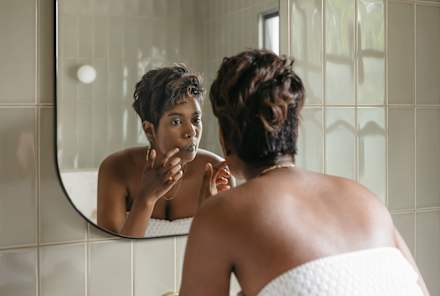Advertisement
How To Hack Your Brain To Have Multiple Orgasms (Yes, You Can Do It)

Despite what you might think, orgasms don't actually start anywhere near the clitoris. Yes, you read that correctly. While the clitoris is the central area for touch, vibration, etc., to elicit orgasms in clitoris-owning people, there is a player in this pleasure game that is far more important: the brain.
All of your sexual desire and feelings start in the mind. It's your body's biggest sex organ. That means your brain is also the key to having multiple orgasms. It plays a crucial role in getting you to that next big O.
If you've been wondering how to have multiple orgasms, here is what you need to know about hacking your brain for greater pleasure.
The brain and pleasure.
Pleasure starts in the brain. Studies have shown1 that stimulation of the clitoris, nipples, and other erogenous zones light up the same areas of the brain that indicate pleasure, namely the sensory cortex. This same brain center lights up when we think about sexual fantasies, pleasurable past sexual experiences, etc.
As Stanley Rosenburg explains in Accessing the Healing Power of the Vagus Nerve, the brain, nervous system, and urethral-clitoral network are in a constant feedback loop. The brain gets turned on by sexual stimuli such as kissing or touching a partner, seeing erotic images, watching pornography, or having a sexual fantasy. It then sends a signal to the clitoris that you're feeling sexual pleasure. The body then responds by becoming sexually aroused; the vagina lubricates itself, the clitoris becomes engorged, and the labia flush pink. This physiological response then sends a positively correlated response to the brain saying, Yes! I am turned on and ready to GO!
See? The brain and clit are in cahoots!
Yes, anyone with a clitoris can have multiple orgasms.
The clitoris is actually kind of huge and contains over 8,000 nerve-endings. The entire clitoral structure goes far deeper into the body than the little nubbin at the top of the vulva. That nub is the glans clitoris, and it's just the tip of the iceberg. The clitoris contains extended bulbs and wings that extend into the labia and abdomen. (If you want to see some images to get a better idea, check out this and this.)
Speaking as a sex researcher, I can say that every single body that has a clitoris is physically capable of having multiple orgasms. The clitoris is the only organ designed entirely for pleasure, so we're physically designed to experience as much pleasure as we want. Vulva owners don't have a refractory period following orgasm (like people with penises do), meaning we can theoretically keep having orgasms until the end of time.
Why you're struggling to have multiple orgasms.
Have you wanted to have multiple orgasms but just can't seem to "get there"? Have you wanted to have multiple orgasms, but your pleasure sort of peters out after the first one?
This is likely due to your mind. While it may seem like our clitorises feel "deadened," it's usually our brains that turn out to be the culprit. Remember, our brains are super powerful.
There are several ways in which we subconsciously stunt ourselves. A lot of the time, we don’t keep pushing for more pleasure because we're holding ourselves back mentally. People raised as women are not told their pleasure matters. We're told that we should give our partner pleasure, and if we get a little, that's cool but not necessary. We don't prioritize female pleasure as a society, which in turn affects the way vulva owners feel about their orgasms. This is why, for example, so many clitoris owners are apprehensive about receiving oral sex; they're worried their partner isn't into it.
Research tells us these mental narratives come with physical consequences. In one study2 of 462 heterosexual women published in the Archives of Sexual Behavior, nearly all of them reported having faked an orgasm at some point in their lives due to the concept that male orgasm was more important than female orgasm. The more a woman had internalized sexist beliefs, the more likely she was to fake her orgasms to appease her partner.
We see other instances of this mind-body connection elsewhere in the scientific literature: A recent study in the Journal of Sex and Marital Therapy showed a positive correlation between positive body image, for example, and sexual functioning (i.e., levels of arousal, desire, lubrication, and yes, orgasm frequency). Our brains are so powerful, some research suggests many instances of vulvodynia (pain of the vulva and vaginal area) can actually be linked to high anxiety and depression in women. That's how interconnected out brains are to our genitals.
How can you have multiple orgasms if you have such negative thoughts around sexuality and yourself? These mental hang-ups lead to a perpetual negative feedback loop that can affect our ability to keep orgasming, even though physically we should be able to. We are told our pleasure is not that important, so if we come, we're like, "OK. Great. I'm finished." It closes us off. If you tell yourself you're not going to come again, your clitoris is too sensitive to be touched, or your partner is bored with giving you pleasure, you're definitely not going to come again. We manifest this limitation through our negative thinking.
How to hack your brain to have multiple orgasms.
1. Break the cycle.
The first thing we have to do is break the cycle in our minds. I'm here to tell you, you absolutely can have multiple orgasms. Start with positive thinking. Tell yourself out loud in the mirror: I am capable of having as much pleasure as I want. And I deserve it.
When you're with a partner, tell yourself over and over again that your pleasure is bountiful. Put aside the negative thoughts. Think with determination: I am going to have more than one orgasm today.
2. Masturbate. Every single day.
Masturbation gives you an opportunity to try different things without the pressure of having a partner present. The more you masturbate, the better acquainted your body and brain become with the sexual response cycle and orgasm. What better excuse could there be?
There are so many ways to touch a clitoris that don't involve straight-up touching it directly. If your clitoris is too sensitive (or even painful) after orgasm, try touching other areas of the body. Stimulate your nipples, run your vibrator over your outer and inner labia. You can even rest it on your pubic mound (the area where your pubic hair grows).
Don't be afraid to try different things. Your partner is not responsible for your orgasm. You are. So learn what you like and get confident in your body.
3. Make partnered sex about you.
Do sex stuff that actually gives you pleasure. Spoiler: Vaginal intercourse very, very rarely results in an orgasm for clitoris-owning people. As sexuality professor and licensed psychologist Laurie Mintz, Ph.D., points out in Becoming Cliterate, there are barely any touch-sensitive nerves in the vagina. You probably won't have one orgasm, let alone multiple, with vaginal intercourse alone.
If you've been masturbating, you know what brings you pleasure. Get your partner on board to have sex sessions entirely devoted to your pleasure. Experiment with toys, receive oral sex, go for blended orgasms, and try sex positions that optimize clitoral stimulation (like this one).
4. Give yourself a break.
Remember, if you feel too overstimulated, take a break. Have a make-out session for a few minutes while your body gets ready for more pleasure.
Lastly, if you don't experience multiple orgasms, that's OK too. At the very least, you'll find out a whole lot about your threshold for experiencing pleasure. That's what sex is really about. Orgasms are great, but they aren't the most important thing. As long as you're having fun, experiencing pleasure, and walking away feeling great about yourself, you're a winner.











